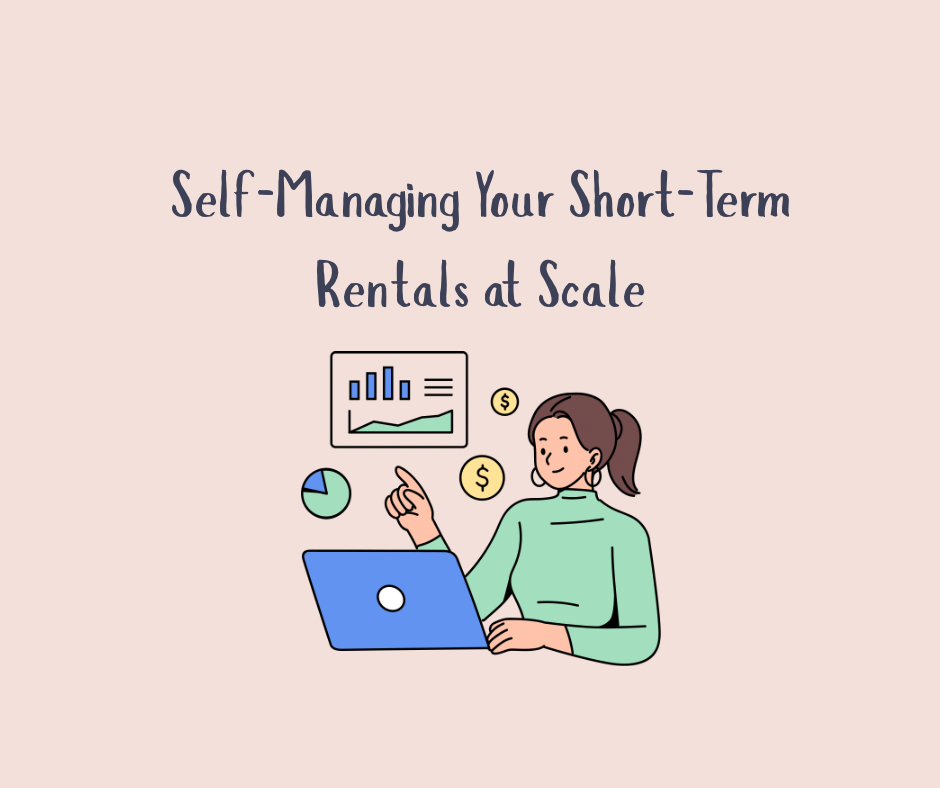Self‑Managing Your Short‑Term Rentals at Scale
- Symple Leases
- Aug 7
- 4 min read
Updated: Aug 27
Introduction
Managing one Airbnb can be a rewarding side hustle, but managing five, ten, or more short-term rentals? That’s a real business. Many hosts believe that once they reach a certain number of properties, they need to hire a property manager, but that’s not always the case. With the right strategy, tools, and mindset, you can self-manage Airbnb listings at scale and keep your operations lean, efficient, and highly profitable.
In fact, some of today’s most successful short-term rental entrepreneurs have found that self-managing short-term rentals gives them more control over guest experiences, allows for faster scaling, and – most importantly – helps them retain more of their revenue. Whether you're looking to grow from 2 to 20 properties or you're just starting with scalability in mind, this guide will walk you through the exact steps to self-manage Airbnb properties like a pro,
without burning out or getting buried in admin.

Why Self-Manage Short-Term Rental Listings?
Many hosts choose to self-manage Airbnb listings to:
Retain more profits by avoiding 20–30% property management fees
Maintain brand consistency and guest satisfaction
Stay agile, making quick operational and pricing adjustments
Build equity through better oversight and reporting
As you scale from 1 to 5 to 10+ properties, you don’t need to surrender control—you just need better tools, clearer systems, and strategic delegation.
Laying the Foundation for Growth

Build Your Local Support Network
A common myth is that “self-managing” means doing everything yourself. In truth, scaling requires strategic outsourcing. You’ll need to assemble a dependable team in each location.
Cleaning crew – consider using apps to find cleaners and for scheduling automation.
Maintenance partner – a handyman on a retainer saves time and panic.
A laundry service or linen rotation – keeps turnovers efficient.
This team ensures your guests have a 5-star experience even if you live across the country.
Stay Legally Compliant
As your short-term rental footprint grows, so does your exposure to regulatory risk. Cities like New York, Los Angeles, and San Francisco have strict regulations regarding business licenses, insurance requirements, and tax filings.
Be sure to research local guidelines using resources like Rent Responsibly or Rental Scale-Up. Compliance early on prevents costly shutdowns later.
Automate Operations From Day One
Choose the Right PMS (Property Management System)
A PMS is your command center – it syncs your calendar, automates communication, and integrates with pricing and cleaning tools.
Great options for self-managing hosts include:
Hospitable (guest communication, automated reviews)
OwnerRez (calendar sync, taxes, accounting)
Hostaway (channel manager + CRM)
With these platforms, a single dashboard can manage 10, 20, and even 50 properties.
Automate Messaging, Tasks, & Reviews
Responding to inquiries, sending check-in details, and following up on reviews are all time-consuming tasks. Tools like Hospitable allow you to pre-schedule:
Instant booking confirmations
Pre-arrival tips and house rules
Scheduled maintenance notifications
Review prompts post-checkout
This level of automation keeps your response rate high and guest experience consistent.
Streamline Turnovers
Apps like Symple Leases can assign cleaning jobs and inspections based on check-in/out times, send supply checklists, and verify task completion through photos and timestamps.
This removes the guesswork and micromanagement from your day-to-day to-do list.
Pricing & Performance Optimization
Use Dynamic Pricing
Dynamic pricing tools like PriceLabs or AirDNA ensure your nightly rates adjust based on:
Competitor rates
Events and holidays
Booking lead times
Seasonality
Even a 5–10% increase in RevPAR (revenue per available rental) can make a major difference at scale.
Optimize Listings with A/B Testing
Platforms like Rankbreeze allow you to test listing photos, titles, descriptions, and amenities to determine what drives more clicks and bookings.
At scale, every percentage point increase in conversion rate means higher occupancy and profits.
Managing Finances & Guest Experiences
Track KPIs That Matter
It’s easy to lose visibility across multiple properties. Set up dashboards to monitor:
Occupancy rate
Average daily rate (ADR)
Revenue per listing
Cost per turnover
Review scores
Use platforms like OwnerRez or Lodgify to keep detailed financial reports and integrate directly with your bank or Stripe.
Deliver Consistent 5-Star Experiences
As you scale, consistency becomes king. Create systems for:
Guest welcome kits (coffee, snacks, local tips)
Local Recommendations
Emergency contact info
Easy check-in (smart locks + instructions)
Mid-stay outreach to catch issues early
Remember: great guest reviews are the cheapest marketing you can buy.
Scaling Strategies: From 5 to 50 Properties
Batch Your Workflows
Use SOPs (Standard Operating Procedures) for repetitive tasks such as:
Cleaning & inspection checklists
Guest messaging templates
Maintenance reporting flow
Onboarding new properties
Batching and templatizing help you train team members and maintain quality at scale.
Leverage Virtual Assistants
Once you hit 10+ listings, consider hiring a virtual assistant to:
Manage inboxes
Handle guest screening
Coordinate with cleaners
Update pricing calendars
A trained VA can handle 80% of your Airbnb workload for $5–$10/hr.

Final Thoughts: Systemize to Scale
Self-managing your short-term rentals at scale is entirely possible—but it requires intentional systems, the right tools, and a willingness to delegate wisely. With software doing the heavy lifting and a reliable team on the ground, you can grow a profitable Airbnb business that doesn’t require being glued to your phone.
The future of short-term rentals belongs to agile, tech-enabled hosts who provide personal experiences at scale – that can be you.
